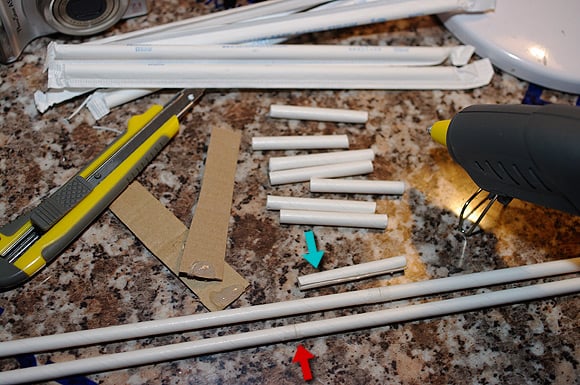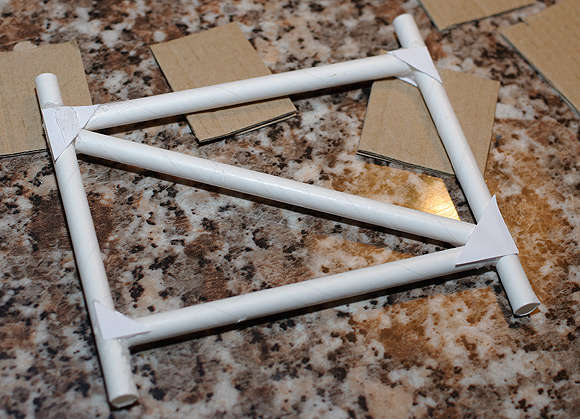Original URL: https://www.theregister.com/2010/07/06/paris_glue/
PARIS in hot glue gun action
Paper straw structure begins to take shape
Posted in Science, 6th July 2010 12:02 GMT
We're obliged to all of you who offered suggestions yesterday as to how to adequately join the recently-arrived paper straws which will form the structure of the Paper Aircraft Released Into Space (PARIS) Vulture 1 vehicle.
 We got straight down to testing a few alternatives, including PVA and superglue, but there was one option which really did deliver - hot glue.
We got straight down to testing a few alternatives, including PVA and superglue, but there was one option which really did deliver - hot glue.
Having decided this was the way to go, we kicked off by butt jointing together a few straws. To do this, we simply hacked off a 50mm length of straw and cut a slit in it lengthways, allowing us to "squash" it slightly.
We then applied some hot glue to this "connector" and slipped it gently into the ends of the two straws. Giving these a few twists to ensured plenty of glue/paper contact and it was just a matter of easing the two ends of the straws together, and cleaning off the excess glue before it dried.
The result was a solid, almost seamless joint (indicated by the red arrow) stronger than the straws themselves. The blue arrow shows the sliced connector:

Well, we quickly put together a piece of test structure to see how the hot glue worked on some "T" and diagonal joints. Pretty well, but the addition of some paper corner braces really did the trick. Before you protest, this mock-up took about five minutes to assemble. We'll be a little more loving with the Vulture 1 structure:

Next up on the structural front is a freezing test, to see how well the straws cope with the cold and whether they need an external treatment. We'll then work on the outer skin - what paper to use, how to attach it to the structure and how to treat Vulture 1's exposed exterior.
And now, for the benefit of those readers who've protested that Vulture 1 is not a "100 per cent" paper aircraft, we'd like to explain just why it isn't a dart folded from a single sheet of A4...
The original inspiration for PARIS came from a couple of sources: high-altitude ballooning projects such as Cambridge University Spaceflight and the Icarus Project; and the audacious Japanese International Space Station origami plane launch plan.
Back in 2008, the University of Tokyo hooked up with the Japan Origami Airplane Association to develop an aircraft capable of re-entering Earth's atmosphere.
This "splendidly pointless" mission, as we described it at the time, has not to date got past the testing stage, which involved "testing an eight-centimetre prototype in an ultra-high-speed wind tunnel at the University of Tokyo".
Significantly, the protoype was treated to "withstand intense heat", which at a stroke made it a less than 100 per cent paper aircraft.
This kind of compromise is unavoidable, if you want your vehicle to survive the mission. In our case, Vulture 1 has to survive a drop from 20,000 metres. It's pretty bloody rough and cold up there, so we offer no apologies for using glue and paper treatments to ensure its survival.
We could, though, leave it at that and have Vulture 1 as nothing more than a paper shell held together with a small percentage of glue and with a thin coating of lacquer or something similar.
However, the aircraft will be carrying a 100 per cent non-paper payload, in the form of a miniature camera and APRS/GPS telemetry transmitter. The reason is straightforward enough: going to all this trouble and releasing Vulture 1 from on high would be an entirely pointless exercise if the last you ever saw of your creation was it drifting towards the heavens under a meteorological balloon.
The Japanese origami project faced this problem: it's all well and good chucking your paper plane out of the ISS, but if it's never seen again and there's no record of the flight, how do you know the thing succeeded?
Shinji Suzuki, an aerospace engineering professor at the University of Tokyo, said at the time: “We hope the space station crew will write a message of peace on the plane before they launch it. We don’t know where in the world the plane will land, but it would be nice to send a message to whoever finds it.”
With due respect to Professor Suzuki, we reckon the chances of the plane ever being recovered, assuming it survives the descent, are practically zero.
In summary, there's no way we're going to all this effort if we don't have Vulture 1 flight telemetry data, a reasonably good chance of recovering the aircraft, and, hopefully, onboard camera snaps of the adventure.
Finally, we'd like to light-heartedly cite precedent in the form of the De Havilland Mosquito. This classic aircraft was dubbed the "Wooden Wonder" - a scandalously misleading description given that, despite its balsawood, birch and spruce structure, it had significant components not containing any wood whatsoever.
No doubt, however, one of you lot will be able to offer a cunning method of constructing Rolls Royce Merlin engines from mahogany without the benefit of either casein or synthetic urea-formaldehyde adhesives.
Now, if you'll excuse us, we're off to worry some paper straws. ®
Additional PARIS resources
- Our dedicated PARIS section, with all previous updates, is right here.
- New to PARIS? We have a basic mission summary here (pdf).
- Check out our YouTube channel - currently featuring a few camera tests.